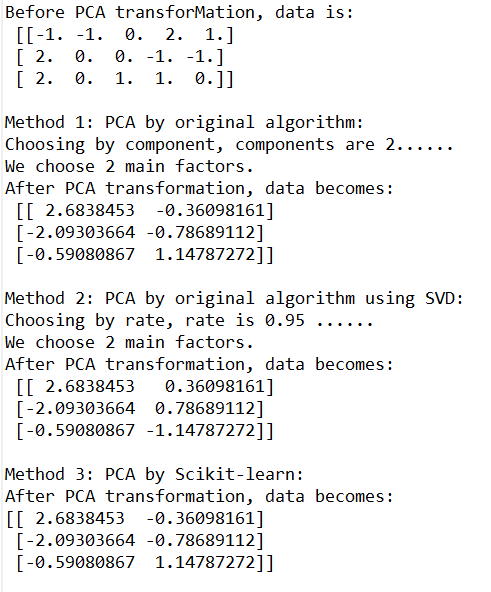主成分分析,即Principal Component Analysis(PCA),是多元统计中的重要内容,也广泛应用于机器学习和其它领域。它的主要作用是对高维数据进行降维。PCA把原先的n个特征用数目更少的k个特征取代,新特征是旧特征的线性组合,这些线性组合最大化样本方差,尽量使新的k个特征互不相关。关于PCA的更多介绍,请参考:https://en.wikipedia.org/wiki/Principal_component_analysis.
主成分分析(PCA) vs 多元判别式分析(MDA)
PCA和MDA都是线性变换的方法,二者关系密切。在PCA中,我们寻找数据集中最大化方差的成分,在MDA中,我们对类间最大散布的方向更感兴趣。
一句话,通过PCA,我们将整个数据集(不带类别标签)映射到一个子空间中,在MDA中,我们致力于找到一个能够最好区分各类的最佳子集。粗略来讲,PCA是通过寻找方差最大的轴(在一类中,因为PCA把整个数据集当做一类),在MDA中,我们还需要最大化类间散布。
在通常的模式识别问题中,MDA往往在PCA后面。
PCA的主要算法如下:
- 组织数据形式,以便于模型使用;
- 计算样本每个特征的平均值;
- 每个样本数据减去该特征的平均值(归一化处理);
- 求协方差矩阵;
- 找到协方差矩阵的特征值和特征向量;
- 对特征值和特征向量重新排列(特征值从大到小排列);
- 对特征值求取累计贡献率;
- 对累计贡献率按照某个特定比例,选取特征向量集的字迹合;
- 对原始数据(第三步后)。
其中协方差矩阵的分解可以通过按对称矩阵的特征向量来,也可以通过分解矩阵的SVD来实现,而在Scikit-learn中,也是采用SVD来实现PCA算法的。
本文将用三种方法来实现PCA算法,一种是原始算法,即上面所描述的算法过程,具体的计算方法和过程,可以参考:A tutorial on Principal Components Analysis, Lindsay I Smith. 一种是带SVD的原始算法,在Python的Numpy模块中已经实现了SVD算法,并且将特征值从大从小排列,省去了对特征值和特征向量重新排列这一步。最后一种方法是用Python的Scikit-learn模块实现的PCA类直接进行计算,来验证前面两种方法的正确性。
用以上三种方法来实现PCA的完整的Python如下:
|
1
2
3
4
5
6
7
8
9
10
11
12
13
14
15
16
17
18
19
20
21
22
23
24
25
26
27
28
29
30
31
32
33
34
35
36
37
38
39
40
41
42
43
44
45
46
47
48
49
50
51
52
53
54
55
56
57
58
59
60
61
62
63
64
65
66
67
68
69
70
71
72
73
74
75
76
77
78
79
80
81
82
83
|
import numpy as npfrom sklearn.decomposition import PCAimport sys#returns choosing how many main factorsdef index_lst(lst, component=0, rate=0): #component: numbers of main factors #rate: rate of sum(main factors)/sum(all factors) #rate range suggest: (0.8,1) #if you choose rate parameter, return index = 0 or less than len(lst) if component and rate: print('Component and rate must choose only one!') sys.exit(0) if not component and not rate: print('Invalid parameter for numbers of components!') sys.exit(0) elif component: print('Choosing by component, components are %s......'%component) return component else: print('Choosing by rate, rate is %s ......'%rate) for i in range(1, len(lst)): if sum(lst[:i])/sum(lst) >= rate: return i return 0def main(): # test data mat = [[-1,-1,0,2,1],[2,0,0,-1,-1],[2,0,1,1,0]] # simple transform of test data Mat = np.array(mat, dtype='float64') print('Before PCA transforMation, data is:\n', Mat) print('\nMethod 1: PCA by original algorithm:') p,n = np.shape(Mat) # shape of Mat t = np.mean(Mat, 0) # mean of each column # substract the mean of each column for i in range(p): for j in range(n): Mat[i,j] = float(Mat[i,j]-t[j]) # covariance Matrix cov_Mat = np.dot(Mat.T, Mat)/(p-1) # PCA by original algorithm # eigvalues and eigenvectors of covariance Matrix with eigvalues descending U,V = np.linalg.eigh(cov_Mat) # Rearrange the eigenvectors and eigenvalues U = U[::-1] for i in range(n): V[i,:] = V[i,:][::-1] # choose eigenvalue by component or rate, not both of them euqal to 0 Index = index_lst(U, component=2) # choose how many main factors if Index: v = V[:,:Index] # subset of Unitary matrix else: # improper rate choice may return Index=0 print('Invalid rate choice.\nPlease adjust the rate.') print('Rate distribute follows:') print([sum(U[:i])/sum(U) for i in range(1, len(U)+1)]) sys.exit(0) # data transformation T1 = np.dot(Mat, v) # print the transformed data print('We choose %d main factors.'%Index) print('After PCA transformation, data becomes:\n',T1) # PCA by original algorithm using SVD print('\nMethod 2: PCA by original algorithm using SVD:') # u: Unitary matrix, eigenvectors in columns # d: list of the singular values, sorted in descending order u,d,v = np.linalg.svd(cov_Mat) Index = index_lst(d, rate=0.95) # choose how many main factors T2 = np.dot(Mat, u[:,:Index]) # transformed data print('We choose %d main factors.'%Index) print('After PCA transformation, data becomes:\n',T2) # PCA by Scikit-learn pca = PCA(n_components=2) # n_components can be integer or float in (0,1) pca.fit(mat) # fit the model print('\nMethod 3: PCA by Scikit-learn:') print('After PCA transformation, data becomes:') print(pca.fit_transform(mat)) # transformed data main() |
运行以上代码,输出结果为:

这说明用以上三种方法来实现PCA都是可行的。这样我们就能理解PCA的具体实现过程啦~~有兴趣的读者可以用其它语言实现一下哈
以上就是本文的全部内容,希望对大家的学习有所帮助,也希望大家多多支持服务器之家。
原文链接:https://www.cnblogs.com/jclian91/p/8024101.html










